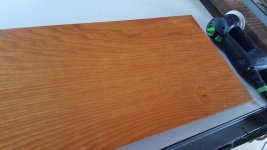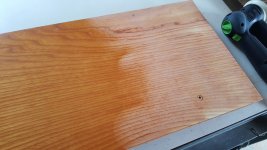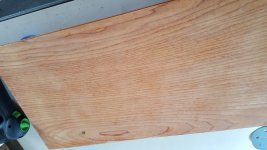idratherplaytennis
Member
- Joined
- Jul 6, 2015
- Messages
- 68
So- I finally got back to my 30 cabinet doors I'm sanding through the finish and part of the color which seems to have been added through it as well, but I'm coming up with some questions... wondering if I am doing this right, or if I could be doing something better- and I would like some opinions on the matter.
First- the finish is on a veneered piece of wood- unsure what type it is, and it's a strange plywood. The actual door has a veneer, followed by a solid layer beneath that, then there are vertical strips of wood laminated together, then another solid layer and then the veneer. The clear coat is probably not 25-30 years old like I originally thought, my parents believed they refinished them a few years ago- but they don't remember what they used, when or how. That said, they had a golden yellowish tint to them, and so I'm believing it was an oil-based clear coat, something no longer easy to obtain in the wonderful state of California, regulation capital of the world where everything and it's mother is known to the state to cause cancer, birth defects and Lord knows what else.
Now the sanders and methods I have been attempting, keeping in mind I'm relatively new to the Festool sanders (I think I may very well still be within my 30 day trial). I've been using a mix of the RO90 as well as the ETS EC150/3 trying to obtain the best results, with the end-goal to be to clear-coat the cabinets with an easily obtainable satin poly, and- if need be, to stain to get a more uniform color. I've noticed after sanding (and most of this is hindsight now, but I still want to learn, regardless of what happens) that some spots come out appearing with a reddish hue, while other times, when the sander takes a lot more out, it comes out more white-ish. As these have been refinished before, I am trying to be VERY careful not to burn through the veneer, however I have for the most part managed to be pretty successful with running a combo of (currently) RO90 in rotex mode with 80 grit to break through the finish and get to the raw wood, with plans to run over that with the ETS EC 150/3 with 80, then 150, then 220, the last two being really light passes to just get the smoothness in prior to finishing. I've only used a couple 2 or 3 sheets on the RO90 so far, however sometimes, the results are stellar- sometimes I get these strange scratch patterns. I've studied the videos and images and forums for proper hand hold techniques, but I don't know if that's the issue. Lately I've been trying to hold the hose area with one hand for balance, and instead of the other hand on top of the head of the rotex, I've been wrapping my index and thumb finger around the curvature at the base above the pad to try to stabilize it to stay flat, but sometimes it just doesn't like to. The DC suction is set to as low as it can go, and I've tried 4, 5 and 6 speeds. The higher the speed, generally the better it goes. I've also attempted the 150/3 however it takes significantly longer to get to the desired level of sanding, however due to it's larger size, it floats like a champ and I have no issue there. I think the larger pad helps (I've only ever used half sheet finish sanders for a couple decades until now...) to keep it steady.
So- I tried to provide all the info- should I be changing paper more often? I'm about 25 doors down with 4 or 5 left to do, on 2 sheets. They seem okay, but I tried to wait to change them until buildup started to happen. I did try to minimize build-up by wiping the the doors down with mineral spirits to get extra grime off, but the tenants who lived in the apartment cooked a LOT and it was an older apartment with poorly-designed ventilation.
Also- is the grit okay? It's not burning through the wood, but what grits and orders would you guys do? I've traditionally only used fixed orbital sanders, 1/2 sheets with small 2-3mm orbits, and gone from 80 to 150 to 220 for most work (not high end finish, usually paint grade or decent finish for rental units), and the grit selection sounded okay to the local Festool guy at Anderson's Plywood in Los Angeles where I bought these.
Side note- by the time the responses roll in, I should be done with the RO90, and onto just smoothing out the scratch marks, however I really would appreciate your perspectives. I'll probably also put in a call to Allen Kensley if he's free since I think he lives in Santa Monica, and maybe he could show me some tips. Alternatively- if any of you live in the Culver City/West Los Angeles area, and wouldn't mind showing me some tips, that could help to- and I'd even be willing to travel to see/learn.
First- the finish is on a veneered piece of wood- unsure what type it is, and it's a strange plywood. The actual door has a veneer, followed by a solid layer beneath that, then there are vertical strips of wood laminated together, then another solid layer and then the veneer. The clear coat is probably not 25-30 years old like I originally thought, my parents believed they refinished them a few years ago- but they don't remember what they used, when or how. That said, they had a golden yellowish tint to them, and so I'm believing it was an oil-based clear coat, something no longer easy to obtain in the wonderful state of California, regulation capital of the world where everything and it's mother is known to the state to cause cancer, birth defects and Lord knows what else.
Now the sanders and methods I have been attempting, keeping in mind I'm relatively new to the Festool sanders (I think I may very well still be within my 30 day trial). I've been using a mix of the RO90 as well as the ETS EC150/3 trying to obtain the best results, with the end-goal to be to clear-coat the cabinets with an easily obtainable satin poly, and- if need be, to stain to get a more uniform color. I've noticed after sanding (and most of this is hindsight now, but I still want to learn, regardless of what happens) that some spots come out appearing with a reddish hue, while other times, when the sander takes a lot more out, it comes out more white-ish. As these have been refinished before, I am trying to be VERY careful not to burn through the veneer, however I have for the most part managed to be pretty successful with running a combo of (currently) RO90 in rotex mode with 80 grit to break through the finish and get to the raw wood, with plans to run over that with the ETS EC 150/3 with 80, then 150, then 220, the last two being really light passes to just get the smoothness in prior to finishing. I've only used a couple 2 or 3 sheets on the RO90 so far, however sometimes, the results are stellar- sometimes I get these strange scratch patterns. I've studied the videos and images and forums for proper hand hold techniques, but I don't know if that's the issue. Lately I've been trying to hold the hose area with one hand for balance, and instead of the other hand on top of the head of the rotex, I've been wrapping my index and thumb finger around the curvature at the base above the pad to try to stabilize it to stay flat, but sometimes it just doesn't like to. The DC suction is set to as low as it can go, and I've tried 4, 5 and 6 speeds. The higher the speed, generally the better it goes. I've also attempted the 150/3 however it takes significantly longer to get to the desired level of sanding, however due to it's larger size, it floats like a champ and I have no issue there. I think the larger pad helps (I've only ever used half sheet finish sanders for a couple decades until now...) to keep it steady.
So- I tried to provide all the info- should I be changing paper more often? I'm about 25 doors down with 4 or 5 left to do, on 2 sheets. They seem okay, but I tried to wait to change them until buildup started to happen. I did try to minimize build-up by wiping the the doors down with mineral spirits to get extra grime off, but the tenants who lived in the apartment cooked a LOT and it was an older apartment with poorly-designed ventilation.
Also- is the grit okay? It's not burning through the wood, but what grits and orders would you guys do? I've traditionally only used fixed orbital sanders, 1/2 sheets with small 2-3mm orbits, and gone from 80 to 150 to 220 for most work (not high end finish, usually paint grade or decent finish for rental units), and the grit selection sounded okay to the local Festool guy at Anderson's Plywood in Los Angeles where I bought these.
Side note- by the time the responses roll in, I should be done with the RO90, and onto just smoothing out the scratch marks, however I really would appreciate your perspectives. I'll probably also put in a call to Allen Kensley if he's free since I think he lives in Santa Monica, and maybe he could show me some tips. Alternatively- if any of you live in the Culver City/West Los Angeles area, and wouldn't mind showing me some tips, that could help to- and I'd even be willing to travel to see/learn.




